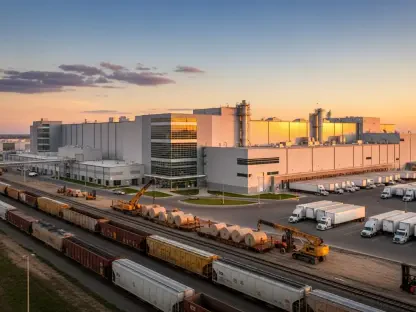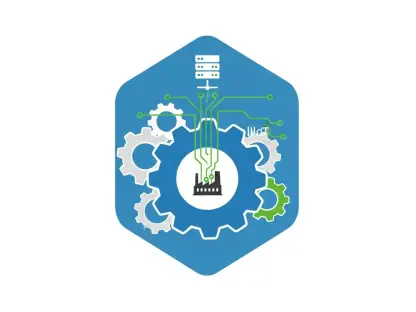In an era where efficiency and precision define industrial success, automation stands as a transformative force across sectors like food processing, pharmaceuticals, and logistics, propelling significant advancements. The automatic weigh price labeling machine market exemplifies this shift, with projections indicating a remarkable rise from USD 351.1 million this year to USD 678.6 million by 2035, reflecting a robust compound annual growth rate (CAGR) of 6.8%. This near-doubling in market value signals a profound reliance on automated solutions to address the escalating demands for speed, accuracy, and regulatory compliance. As industries grapple with complex supply chains and heightened consumer expectations, these machines are emerging as indispensable tools. By 2030, the market is expected to surpass USD 487.8 million, showcasing a steady trajectory of growth. This article delves into the forces propelling this expansion, from technological breakthroughs to sectoral and regional trends, painting a clear picture of automation’s pivotal role over the next decade.
Market Expansion and Key Drivers
Automation as a Core Necessity
Automation has become a cornerstone for industries striving to keep pace with modern operational demands, particularly in food processing and logistics. The need for speed and precision in labeling processes is paramount, as errors can disrupt production lines and lead to significant financial losses. Automatic weigh price labeling machines address these challenges by integrating seamlessly with existing systems, enhancing throughput while reducing human error. Their ability to handle high volumes with consistent accuracy makes them vital in environments where time is of the essence. Beyond mere efficiency, these machines ensure compliance with increasingly stringent regulations, a critical factor for manufacturers under constant scrutiny. As global markets grow more interconnected, the pressure to maintain flawless operations intensifies, positioning automation not as a luxury but as a fundamental requirement for staying competitive in a fast-evolving landscape.
The surge in e-commerce further underscores the necessity of automated labeling solutions, especially in warehousing and omni-channel retail settings. With online shopping driving unprecedented demand for rapid order fulfillment, logistics operations face immense pressure to label and dispatch goods swiftly and accurately. Automatic weigh price labeling machines, particularly those designed for medium to bulk loads in the 13 to 60 kg range, hold a dominant 44% market share due to their adaptability across various product types. This versatility allows warehouses to manage diverse inventories without sacrificing speed or precision. The rise of same-day delivery models and consumer expectations for transparency in shipping only heighten the reliance on such technology. As digital marketplaces continue to expand, the role of automation in ensuring efficient labeling becomes a key differentiator for businesses aiming to meet the relentless pace of modern retail.
Regulatory Pressures and Strategic Importance
Labeling has evolved far beyond a routine task, emerging as a strategic asset for industries navigating a maze of global regulations. Regulatory bodies worldwide are tightening standards, making accurate labeling essential for compliance and safeguarding consumer trust. Errors or inconsistencies can result in penalties, product recalls, or reputational damage, risks that manufacturers cannot afford. Automatic weigh price labeling machines offer a reliable solution by delivering precision and uniformity in every label, ensuring that products meet legal requirements across markets. This capability is especially critical in sectors like pharmaceuticals and food processing, where safety and traceability are non-negotiable. As regulations grow more complex, the ability of these machines to adapt to varying compliance needs positions them as indispensable tools for long-term operational stability.
Beyond compliance, the strategic value of automated labeling lies in its capacity to enhance transparency and traceability, fostering stronger connections with consumers. In an age where buyers demand detailed product information, features like QR codes and digital tracking integrated into labels provide a direct line of communication between brands and their audiences. Automatic weigh price labeling machines enable this by embedding such data seamlessly during production, ensuring every item carries verifiable details about its origin and journey. This not only builds trust but also aligns with market trends favoring accountability. Additionally, the consistency offered by automation protects brand integrity by minimizing discrepancies that could undermine credibility. As industries face growing scrutiny from both regulators and consumers, these machines serve as a bridge between operational efficiency and market expectations, redefining labeling as a cornerstone of business strategy.
Technological Innovations Fueling Growth
Cutting-Edge Advancements
The growth of the automatic weigh price labeling machine market is intricately tied to rapid technological advancements that redefine operational capabilities. Innovations such as AI-enabled systems are at the forefront, minimizing errors by intelligently detecting and correcting discrepancies in real-time during the labeling process. Digital touch-screen interfaces further simplify user interaction, allowing operators to manage complex tasks with ease and precision. Smart labeling features, including QR codes and augmented reality, are also gaining traction, enabling manufacturers to provide interactive product information to consumers while streamlining compliance documentation. Leading companies like Marel and Bizerba are driving these next-generation designs, investing heavily in research to push the boundaries of what these machines can achieve. Such progress not only boosts efficiency but also sets new industry standards for accuracy and engagement.
Another dimension of these advancements lies in how they cater to evolving market needs, particularly in customization and adaptability. Modern weigh price labeling machines are being engineered to handle a diverse range of products and packaging formats, ensuring flexibility for manufacturers dealing with varied inventories. The integration of smart features allows for real-time data capture and analysis, offering insights that can optimize production workflows. This technological leap is evident in the way these machines support dynamic labeling requirements, such as multilingual labels or region-specific compliance codes, which are increasingly demanded in global markets. By staying ahead of consumer and regulatory trends, manufacturers of these machines ensure their solutions remain relevant and impactful. This focus on innovation underscores a broader shift toward automation as a driver of both operational excellence and competitive differentiation in a crowded marketplace.
Integration with Industry 4.0
The convergence of weigh price labeling machines with Industry 4.0 principles marks a significant leap toward smarter, more connected manufacturing ecosystems. These machines are now designed to integrate seamlessly with digital networks, enabling real-time data sharing across production lines and supply chains. Such connectivity facilitates predictive maintenance, reducing downtime by identifying potential issues before they escalate. Energy-efficient models are also becoming a benchmark, aligning with global sustainability goals while lowering operational costs for manufacturers. This integration allows businesses to monitor and optimize labeling processes remotely, ensuring consistent performance even in high-pressure environments. As Industry 4.0 continues to reshape industrial landscapes, the adaptability of these machines to interconnected systems positions them as critical components of future-ready operations.
Sustainability and customization further enhance the appeal of these automated solutions within the Industry 4.0 framework, addressing both environmental and operational priorities. Machines are increasingly engineered with eco-friendly materials and power-saving technologies, reflecting a commitment to reducing the carbon footprint of industrial activities. At the same time, customizable formats allow manufacturers to tailor labeling processes to specific product lines or regulatory demands, enhancing flexibility in complex supply chains. This dual focus on green practices and bespoke functionality ensures that automation not only drives efficiency but also aligns with broader corporate responsibility goals. As industries move toward more integrated and sustainable models, the role of weigh price labeling machines in supporting these transitions becomes increasingly vital, paving the way for scalable growth and long-term resilience in a digital-first world.
Sectoral and Regional Insights
Dominance of Food and Beverage
The food and beverage sector stands as the largest adopter of automatic weigh price labeling machines, commanding a substantial 35% share of the global market. This dominance stems from the industry’s stringent requirements for safety, quality, and regulatory compliance across a wide range of products, including dairy, meat, bakery items, and ready-to-eat meals. Accurate labeling is non-negotiable in ensuring that consumers receive correct information about ingredients, allergens, and expiration dates, which directly impacts trust and brand loyalty. Automation addresses these needs by delivering consistent, error-free labels at scale, even under high production volumes. As global food safety standards tighten, the reliance on such technology becomes even more pronounced, enabling manufacturers to meet both legal mandates and market expectations with precision and efficiency.
Consumer-driven trends further amplify the sector’s dependence on automated labeling, with transparency emerging as a key demand in today’s marketplace. Features like QR code integration allow buyers to access detailed product histories, from sourcing to packaging, fostering a deeper connection with brands. The rise of ready-to-eat meals and packaged agricultural goods, fueled by busy lifestyles and e-commerce growth, also drives the need for rapid, reliable labeling solutions. Automatic weigh price labeling machines cater to this surge by ensuring traceability and compliance without slowing down production lines. This adaptability is particularly critical in a sector where seasonal demands and global supply chains add layers of complexity. As consumer expectations for convenience and accountability continue to rise, automation solidifies its role as a linchpin for innovation and trust within the food and beverage industry.
Regional Growth Hotspots
Regional dynamics play a pivotal role in shaping the expansion of the weigh price labeling machine market, with distinct growth patterns emerging across key areas. East Asia leads the charge, with Japan showcasing a remarkable CAGR of 7.7%, driven by advanced automation in food manufacturing and the adoption of IoT-enabled smart labels. China follows closely at 7.3% CAGR, propelled by strict food safety regulations, booming e-commerce, and government support for industrial automation. In Europe, Germany stands out with a 5.5% CAGR, fueled by EU food regulations and a strong push toward Industry 4.0 initiatives. These variations highlight how local industrial priorities and technological adoption rates influence the pace of market growth. As automation becomes more tailored to regional needs, its impact on labeling solutions deepens, reflecting a global yet localized approach to industrial progress.
North America also demonstrates steady advancement, with the United States at a 4.8% CAGR and Canada at 4.5%, driven by regulatory compliance mandates and supply chain modernization. Meanwhile, India’s growth at 6.0% reflects an expanding food processing sector, pharmaceutical exports, and a rising middle class demanding packaged goods. These regional hotspots underscore the diverse drivers behind automation’s rise, from e-commerce expansion to stringent safety standards. Each market adapts the technology to address unique challenges, whether it’s enhancing traceability in Asia or meeting sustainability goals in Europe. This localized adoption ensures that the benefits of weigh price labeling machines are maximized, creating a ripple effect of efficiency and innovation across borders. As these trends evolve, they collectively paint a picture of a market poised for sustained, dynamic growth through 2035.
Reflecting on Automation’s Transformative Impact
Looking back, the journey of automatic weigh price labeling machines reveals a market that adapted swiftly to the demands of a changing industrial landscape. Their evolution from basic tools to sophisticated systems mirrors the broader push toward automation, driven by a need for precision and compliance. By integrating cutting-edge technologies and addressing sectoral challenges, these machines have reshaped how industries approach efficiency and transparency. The growth witnessed across regions like East Asia and Europe highlights a shared recognition of automation’s value in navigating complex regulations and consumer expectations. Moving forward, stakeholders should focus on investing in scalable, sustainable solutions that align with Industry 4.0 principles. Prioritizing innovation and regional customization will ensure that the benefits of this technology continue to expand, empowering manufacturers to build resilient, future-ready operations in an increasingly interconnected world.









